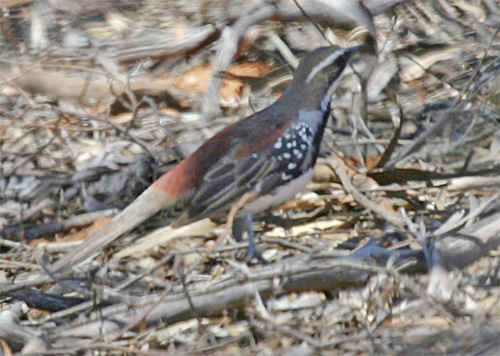(completed) |
|||
| Line 1: | Line 1: | ||
| − | [[Image:Chestnut_Quail_Thrush.jpg|thumb|550px|right|Photo by Pearly_Shells<br /> | + | [[Image:Chestnut_Quail_Thrush.jpg|thumb|550px|right|Male<br />Photo by {{user|Pearly_Shells|Pearly_Shells}}<br />Gludpot Reserve South [[Australia]]]] |
| + | '''Alternative names: Chestnut-backed Quail-thrush; Chestnut Groundbird; Copperback''' | ||
;[[:Category:Cinclosoma|Cinclosoma]] castanotum | ;[[:Category:Cinclosoma|Cinclosoma]] castanotum | ||
| − | |||
==Identification== | ==Identification== | ||
| − | + | 21-26cm. <br /> | |
| − | + | Male: | |
| + | * Black throat, face and upper breast | ||
| + | * White eyebrow and broad white streak on side of throat | ||
| + | * Grey flanks and white central belly | ||
| + | * Grey-brown upper back | ||
| + | * Chestnut shoulder to lower back, forming a band over the upperparts | ||
| + | * White tail tip | ||
| + | Female: | ||
| + | * Paler than male | ||
| + | * Brown face | ||
| + | * Grey upper breast | ||
| + | Juveniles are similar to females. | ||
==Distribution== | ==Distribution== | ||
| − | [[Australia]]. | + | Southwest, south-central and southeast [[Australia]].<br /> |
| + | Locally fairly common. | ||
==Taxonomy== | ==Taxonomy== | ||
| − | There are | + | There are 3 subspecies: |
| + | * ''C. c. clarum'' in southcentral [[Western Australia]], southwest and southcentral [[Northern Territory]] and west [[South Australia]] | ||
| + | * ''C. c. fordianum'' in south [[Western Australia]] and southwest [[South Australia]] | ||
| + | * ''C. c. castanotum'' in southeast [[South Australia]], southwest and central [[New South Wales]] and northwest [[Victoria]] | ||
| + | The described subspecies dundasi is an intergrade between clarum and fordianum. Other proposed subspecies (''mayri'', ''morgani'') are considered indistinguishable from the nominate form. | ||
==Habitat== | ==Habitat== | ||
| − | + | Mallee, low shrubs, dry woodland and heath in arid or semi-arid regions, usually on sandy substrates. | |
==Behaviour== | ==Behaviour== | ||
| − | The diet includes invertebrates such as grasshoppers, beetles, flies, caterpillars, ants | + | The diet includes invertebrates such as grasshoppers, beetles, flies, caterpillars, ants and seeds.<br /> |
| − | + | A shy, elusive bird, foraging on the ground.<br /> | |
| − | It nests in a depression in the ground which is lined with bark, grass and twigs. | + | It nests in a depression in the ground which is lined with bark, grass and twigs. Lays 2 eggs.<br /> |
| − | + | Resident species, in some arid regions also nomadic. | |
==References== | ==References== | ||
| − | + | #{{Ref-Clements6thDec08}}#{{Ref-HBWVol12}}#{{Ref-Simpson98}} | |
| + | {{ref}} | ||
==External Links== | ==External Links== | ||
{{GSearch|Cinclosoma+castanotum}} | {{GSearch|Cinclosoma+castanotum}} | ||
*[http://www.aviceda.org/abid/birdimages.php?action=birdspecies&fid=69&bid=1102 View more images of this species on the ABID] | *[http://www.aviceda.org/abid/birdimages.php?action=birdspecies&fid=69&bid=1102 View more images of this species on the ABID] | ||
[[Category:Birds]] [[Category:Cinclosoma]] | [[Category:Birds]] [[Category:Cinclosoma]] | ||
Revision as of 18:40, 1 November 2009
Alternative names: Chestnut-backed Quail-thrush; Chestnut Groundbird; Copperback
- Cinclosoma castanotum
Identification
21-26cm.
Male:
- Black throat, face and upper breast
- White eyebrow and broad white streak on side of throat
- Grey flanks and white central belly
- Grey-brown upper back
- Chestnut shoulder to lower back, forming a band over the upperparts
- White tail tip
Female:
- Paler than male
- Brown face
- Grey upper breast
Juveniles are similar to females.
Distribution
Southwest, south-central and southeast Australia.
Locally fairly common.
Taxonomy
There are 3 subspecies:
- C. c. clarum in southcentral Western Australia, southwest and southcentral Northern Territory and west South Australia
- C. c. fordianum in south Western Australia and southwest South Australia
- C. c. castanotum in southeast South Australia, southwest and central New South Wales and northwest Victoria
The described subspecies dundasi is an intergrade between clarum and fordianum. Other proposed subspecies (mayri, morgani) are considered indistinguishable from the nominate form.
Habitat
Mallee, low shrubs, dry woodland and heath in arid or semi-arid regions, usually on sandy substrates.
Behaviour
The diet includes invertebrates such as grasshoppers, beetles, flies, caterpillars, ants and seeds.
A shy, elusive bird, foraging on the ground.
It nests in a depression in the ground which is lined with bark, grass and twigs. Lays 2 eggs.
Resident species, in some arid regions also nomadic.
References
- Clements, JF. 2008. The Clements Checklist of Birds of the World. 6th ed., with updates to December 2008. Ithaca: Cornell Univ. Press. ISBN 978-0801445019.
- Del Hoyo, J, A Elliott, and D Christie, eds. 2007. Handbook of the Birds of the World. Volume 12: Picathartes to Tits and Chickadees. Barcelona: Lynx Edicions. ISBN 978-8496553422
- Simpson, K and N Day. 1998. Field Guide to the Birds of Australia. London: Christopher Helm. ISBN 0-7136-4877-5
Recommended Citation
- BirdForum Opus contributors. (2025) Chestnut Quail-thrush. In: BirdForum, the forum for wild birds and birding. Retrieved 2 January 2025 from https://www.birdforum.net/opus/Chestnut_Quail-thrush




